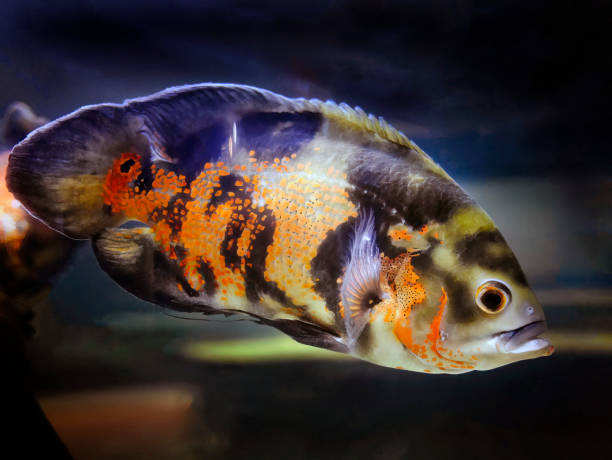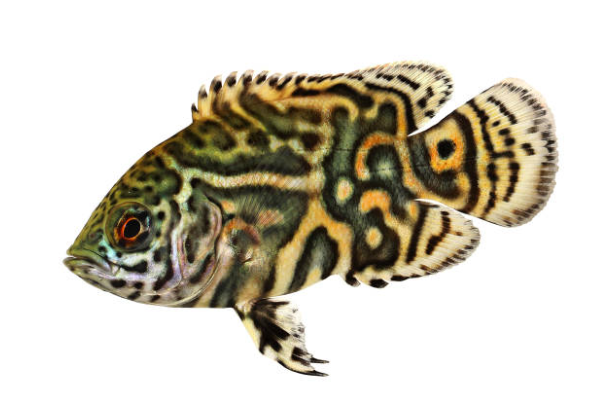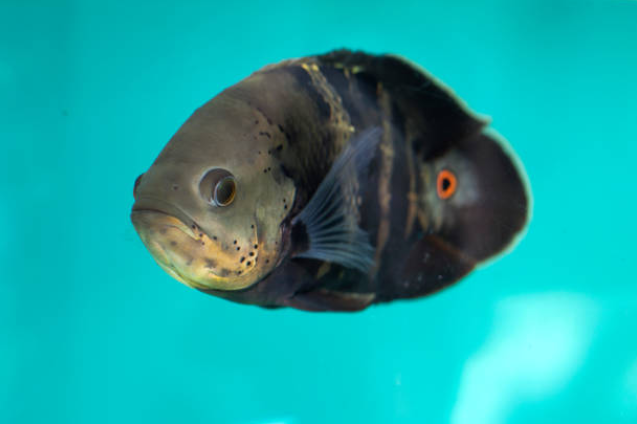All the information you need to successfully keep a Tiger Oscar Fish using these care tips, diet plans, tank setups, breeding and health tips.

Dive into the World of Tiger Oscars: Care, Diet, and Breeding Insights
Hey Aqua lovers, welcome back. Today, we’re reviewing another popular aquarium fish renowned for its striking appearance. It features a dark brown to black body with bright orange or red stripes, resembling a tiger’s fur- The Tiger Oscar.
This Vibrant fish species is a beloved freshwater fish native to South America’s Amazon and Paraná river basins. Due to its vibrant coloration and distinct patterns, it’s a popular choice for home aquariums.
The Oscar fish’s characteristics require experienced care and attentive maintenance. They’re territorial and can be aggressive towards other fish, especially during breeding or defending their territory.
Therefore, it’s essential to research and understand their specific needs and behaviors before introducing them to your aquarium.
History and Origin
The Oscar fish origin is rich and dates back to the ancient rivers of South America. Originating from the Amazon and Paraná river basins, this South American fish species was first discovered in the 18th century, when it thrived and adapted to the region’s unique water conditions, developing its distinctive stripes.
The Tiger Oscar’s history changed trajectory as a native South American fish as aquarium-keeping gained popularity in the early 20th century.
The Tiger Oscar became a highly sought-after species, prized for its vibrant coloration and unique patterns.
Today, the Tiger Oscar is a beloved aquarium pet fish around the world, cherished for its intelligence and beauty.
Physical Characteristics


The Tiger Oscar’s appearance is so unique you can’t possibly mix it up with that of other aquarium fish.
This striking freshwater fish is renowned for its vibrant dark brown to black body with bright orange or red stripes, resembling a tiger’s fur.
The fish’s size and structure are also different from other species. It has an oval-shaped body with a slightly compressed lateral profile and typically grows up to 12 to 14 inches with long, flowing dorsal and anal fins and a rounded caudal fin.
The Oscar fish patterns are the most common variations in its appearance. Some Oscar fish have orange stripes that may vary from bright to pale, while others display irregular or broken stripes and have a more mottled appearance.
This fish’s size and structure make it a striking addition to your aquarium.
Ideal Tank Conditions
I recommend these Tiger Oscar tank conditions to optimally maintain an aquarium setup that guarantees your fish flourishes.
- Tank Size: A large tank with at least 55 gallons (200 liters) for the first Oscar and 20 gallons (75 liters) added for each additional Oscar
- Water Temperature: A stable temperature of 72°F – 82°F (22°C – 28°C) will ensure the fish are comfortable. Also, minimize sudden temperature changes because you do not want to stress these beauties!
- pH Levels: 6.5 – 8.0, with a recommended pH range of 7.0 – 7.5, will produce the best water parameters for Oscars.
- Filtration Requirements: Use a high-quality filter and maintain it regularly to ensure the water remains pure.
Other typical fish tank maintenance practices, such as regular water changes, providing multiple hiding places and decorations, and moderating lightning conditions, also contribute to ideal tank conditions for fish.
Diet and Nutrition
Your Tiger Oscar diet should contain protein-rich foods for optimal health and growth. A varied diet with high-quality foods will ensure your Tiger Oscar receives the necessary nutrients. I recommend the following to ensure you keep a balanced fish diet.
- High-quality commercial pellets or flakes are the main staple.
- Live or frozen foods like blood worms, earthworms, and shrimps.
- Vegetables like peas and cucumbers.
Feeding Tiger Oscars requires your close attention because you do not want to overfeed them, causing risks of water pollution or digestive issues as they’re prone to complications if overfed.
You should feed them only 2-3 times a day and only in bits they can consume in 3 minutes. You should also try as much as possible to maintain a balanced diet that helps support optimal health and growth, develop robust immune systems, and prevent diseases.
By following these dietary guidelines and providing a balanced and varied diet, you will surely get the best nutrition for your Tiger Oscar.
For more on feeding your aquatic pets check out The Ultimate Guide to Fish Food: Pros and Cons & Best Choices!
Behavior and Temperament

Tiger Oscar behavior, compared to other aquarium fish, is unique. They are known for their temperament, which can be both fascinating and challenging.
Although they respond well to a well-maintained tank with plenty of hiding places and visual stimulation, Oscar fish are very territorial and aggressive.
They often aggressively defend their space from other fish. Oscar fish’s aggression is especially towards fish that resemble themselves or enter their territory.
They are knowledgeable, curious fish who do not shy away from fish interaction with tank mates. Try avoiding similar species or those that may be perceived as threats.
Remember that this fish is naturally aggressive, so you must take steps to manage the fish’s temperament. You can do this by providing a large enough tank with plenty of hiding places and visual barriers and introducing tankmates carefully, starting with similar-sized, peaceful fish.
Providing a “territory” or “cave” for your Tiger Oscar to claim as its own and cleaning the tank regularly will also help.
Common Health Issues
Tiger Oscars, like other fish, can be susceptible to various health issues. Here are some common Tiger Oscar health issues and how to prevent and treat them.
Ich (White Spot Disease)
This is a parasitic infection that causes white spots on the fish’s body. Helpful ich prevention tips include maintaining good water quality using our guide and avoiding overcrowding.
Treatment: Increase water temperature to 86°F (30°C), use ich medication, and perform water changes regularly.
Fin Rot
This is one of the most common fish diseases out there, caused by a bacterial infection that causes fin decay and damage. A balanced diet, optimal water conditions, and suitable tank mates are good tips to prevent this.
Treatment: Use antibiotics, improve water quality, and trim damaged fins.
Hole-in-the-Head Disease (H.I.T.H.)
A bacterial infection causing lesions on the head and body of the Tiger Oscar. Maintain good water quality, provide a balanced diet, and avoid stress to reduce the risks of this disease.
Treatment: Use antibiotics, improve water quality, and provide a nutritious diet.
Swim Bladder Issues
Tiger Oscars can experience swim bladder problems, leading to buoyancy issues. Poor eating habits and water quality may cause this.
Treatment: Fast your Tiger Oscar for a few days, then offer small, easily digestible meals. Regularly monitor your Tiger Oscar’s health, quarantine new fish before introducing them to the main tank, and use proper filtration.
By being aware of these potential health issues, taking preventive measures, and using the proper Oscar fish treatment, you can help keep your Tiger Oscar healthy and thriving.
Breeding Tiger Oscars
Make sure you carefully research and plan breeding activities before executing. We provide you with tips you should consider when considering breeding your Tiger Oscar. Here’s an overview of the process:
Selecting Breeding Pairs
Ensure you use healthy, mature fish with desirable traits compatible with your fish.
This video has been very helpful in identifying the sex of Oscar fish, I highly recommend it:
Spawning Conditions
Ensure you use a separate tank with a spawning site and enough hiding places and plants for breeding. Soft, slightly acidic water (pH 6.5-7.0, dH 5-10) with temperatures between 82-86°F/28-30°C should be maintained.
Spawning and Fertilization
Introduce the breeding pairs to the tank. Fish spawning typically occurs in the morning, with the female laying eggs on the spawning site and the male fertilizing the eggs, which fall to the substrate after being fertilized.
Caring for the Fry

Collect the fertilized eggs from the substrate and transfer them to a separate fry tank. Use infusoria or newly hatched brine shrimp as food.
Caring for fish fry is more than just diet; you should strive to maintain water quality and perform regular water changes, as you do not want to affect the growth of your fry negatively.
Challenges and Considerations
- Tiger Oscar’s breeding has a relatively low success rate.
- Breeding pairs may require multiple attempts to spawn successfully.
- Fry are sensitive to water quality and require careful management.
Understanding these specific needs and challenges can increase your chances of successfully breeding and raising a healthy, thriving Tiger Oscar fry.
Tank Mates and Compatibility

Remember, they’re very territorial, aggressive fish when choosing Tiger Oscar tank mates. You must consider other factors such as size, temperament, and swimming levels when choosing suitable tank mates for your fish.
A good pair is a medium-sized peaceful fish (4-6 inches) that occupies different swimming levels(middle, top, or bottom).
Potential Conflicts to Avoid
Aggressive or territorial fish that may fight with the Tiger Oscar, fish with similar size or shape that may be perceived as competitors, schooling fish that the Tiger Oscar’s solitary nature may stress
As you pick out tank mates, prioritize fish compatibility and avoid potential conflicts to ensure a thriving aquarium.
Special Care Requirements
Tiger Oscar Care is not a walk in the park. It requires your time and attention to detail. Follow the following steps for your Tiger Oscar fish grooming:
- Grooming Practices: Regularly clean the tank and decorations to prevent algae buildup, which harms your fish maintenance. Monitor and remove any dead or dying plants.
- Handling: Avoid handling Tiger Oscars excessively, as they can be stressed by netting and handling. Use a soft net and handle them gently, supporting their body and fins.
- Regular Maintenance Tasks: Frequent water changes, monitoring and adjusting water parameters(pH, ammonia) as necessary (pH, ammonia, nitrite, nitrate).
Handling aquarium fish must be done with utmost care. Follow our recommendations to get the best out of your setup!
Conclusion
The Tiger Oscar is a unique and captivating species that requires specific care to thrive. This unique aquarium fish has a striking appearance, intelligent nature, and active personalities that make it a fascinating addition to your tank. By following the fish care tips we’ve provided, you will surely enjoy the rewards of owning this beautiful fish.


